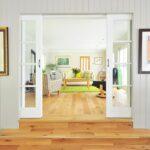So, your living room… it’s… well, it’s lacking a certain *oomph*, isn’t it? No grand fireplace, no breathtaking view out the window, no built-in bookcase practically begging to be photographed for Architectural Digest. You’re dealing with a living room that’s, shall we say, *focal-point challenged*. Fear not! Creating a stunning and inviting space is entirely achievable, even without an obvious anchor. We’re going to explore some sneaky (and not-so-sneaky) ways to conjure visual interest, balance, and style in your focal point-free zone. Think of it as interior design alchemy! Let’s get started, shall we?
Understanding the “Focal Point” Concept
First, let's dissect the idea of a "focal point" itself. A focal point isn't just some random object; it's a design element that naturally draws the eye. Traditional focal points are things like fireplaces, large windows, or impressive architectural details. They provide a sense of order and give the room a natural starting point for arranging furniture and decor.
When you don't have a predetermined focal point, though? Well, you have the freedom to create one! It’s an interesting position to be in. Think of it, if you will, as an opportunity. A blank canvas – it’s exciting!
Creating Your Own Focal Point Magic
Okay, now for the juicy stuff! How do you manufacture a focal point from thin air? Here are several options, ranging from the relatively simple to the slightly more involved, all to find that perfect decor fit.
The Mighty Accent Wall
An accent wall is perhaps the most common and reliable way to introduce a focal point. It's all about visual contrast. Consider painting one wall a bold color that compliments your existing furniture and decor. Think deep teal against neutral furniture, a warm terracotta orange in a room dominated by grays, or even a sophisticated charcoal grey for a touch of drama.
But paint isn't the only option! Wallpaper with a captivating pattern can also be a stunning choice. Texture is your friend, people! Think about adding textured wallpaper like grasscloth, or a geometric design for added dimension.
- Consider the room's size and lighting: Darker colors can make a small room feel even smaller, so be mindful of natural light.
- Don't be afraid to experiment: Order sample swatches of paint or wallpaper to see how they look in your space before committing.
- Think about using a mural. These are getting more advanced and easier to apply than ever, so why not bring the art museum home with you?
The Artful Arrangement
A gallery wall can be a fantastic focal point, especially if you have a collection of art, photographs, or interesting objects. The key is to create a cohesive arrangement that tells a story.
- Mix and match: Don't be afraid to combine different frame styles, sizes, and art mediums. The goal is a collected, curated look, not a perfectly matched set.
- Plan your layout: Before hammering any nails, lay out your arrangement on the floor to experiment with different configurations.
- Consider a statement piece: Start with one large piece of art that you love, and then build your gallery wall around it.
The key to a good gallery wall is starting with a central peice that grounds the entire gallery. It will naturally draw the eye without being too overwhelming.
The Bold Furniture Statement
Sometimes, all you need is one exceptionally striking piece of furniture to act as a focal point. Think a brightly colored velvet sofa, a unique antique cabinet, or an oversized chaise lounge.
- Choose quality over quantity: Invest in a well-made piece that will last for years.
- Consider the scale: Make sure your statement piece is proportionate to the size of your room. An oversized sofa can overwhelm a small space, while a tiny accent chair might get lost in a large room.
- Play with texture: A plush velvet sofa, a rustic wooden cabinet, or a sleek leather armchair can add visual interest and tactile appeal.
Light It Up!
A dramatic lighting fixture can instantly become a focal point. Think oversized pendant lights, ornate chandeliers, or sculptural floor lamps. Lighting fixtures will instantly grab the attention of guests, and bring the room together. The size is up to you and the amount of space to work with, so have fun, and play around!
- Consider the style of your room: Choose a lighting fixture that complements your existing decor. A modern chandelier might look out of place in a traditional living room.
- Think about scale: An oversized pendant light can make a statement in a large room, while a smaller fixture might be better suited for a smaller space.
- Don't forget about function: Lighting should be both beautiful and functional. Make sure your fixture provides adequate light for reading, socializing, and other activities.
Mirrors, Mirrors on the Wall!
A large mirror can instantly create a focal point while also making your room feel larger and brighter. Place it strategically to reflect light and visually expand the space.
- Consider the shape and size: A large rectangular mirror can create a dramatic statement, while a smaller round mirror can add a touch of elegance.
- Pay attention to the reflection: Make sure the mirror reflects something beautiful, such as a window, a piece of art, or a lush plant.
- Try a collection of smaller mirrors: A grouping of smaller mirrors can create a unique and eye-catching focal point.
Built-in Shelving as a Custom Design Touch
Consider adding custom shelving, if your budget allows. It provides storage and a focal point. Style the shelves with books, artwork, plants, and decorative objects.
- Think about the design: Built-in shelving can be tailored to your specific needs and style. Consider adding open shelves, closed cabinets, or a combination of both.
- Pay attention to scale: Make sure the shelving is proportionate to the size of your room. Too-small shelving can look insignificant, while too-large shelving can overwhelm the space.
- Style with intention: Don't just randomly fill your shelves. Arrange items in a way that is visually appealing and tells a story.
Arranging Furniture in a Focal Point-Free Zone
Once you've created a focal point (or a faux-cal point, if you will), you need to arrange your furniture accordingly. Here's where it gets a little tricky, since many people have a hard time getting this done properly.
- Anchor your furniture: Place your largest pieces of furniture facing the newly created focal point. This will help to define the space and create a sense of balance. For instance, if you have an accent wall, place the sofa facing it.
- Create a conversation area: Arrange your furniture in a way that encourages conversation. Place chairs and sofas facing each other, with a coffee table in the center.
- Use rugs to define zones: Area rugs can help to define different zones within your living room, such as a seating area, a reading nook, or a play area.
- Think about your floor plan. If you have a long, narrow living room, think about breaking the furniture up into 2 distinct conversation zones.
The Devil is in the Details: Accessories and Finishing Touches
Accessories are the final flourish that will tie your living room together. They're the sprinkles on the sundae, the cherry on top, the… well, you get the idea.
- Add pops of color: Introduce pops of color through throw pillows, blankets, artwork, and accessories.
- Incorporate texture: Layer different textures to add visual interest and tactile appeal. Think plush velvet pillows, chunky knit blankets, woven baskets, and rough-hewn pottery.
- Bring in nature: Plants are a great way to add life and vibrancy to your living room. Choose a variety of sizes and shapes to create a dynamic display.
- Consider your window treatments carefully. Don't go with the same off-the-rack curtains that everyone uses. Think custom, think bold.
Common Mistakes to Avoid
Even with the best intentions, it's easy to make mistakes when decorating a living room without a focal point. Here are some common pitfalls to avoid:
- Ignoring scale: Make sure your furniture and accessories are proportionate to the size of your room.
- Creating clutter: A cluttered room will feel chaotic and uninviting. Edit your belongings and only display items that you truly love.
- Not considering traffic flow: Make sure there's enough space to move freely around the room.
- Not planning your room beforehand. Draw up a little blueprint, plan everything out on paper, so you don't make huge mistakes in your planning process.
Focal Point Fun: Extra Ideas to Chew On
Still feeling a little stuck? Here are some extra ideas to spark your creativity:
- A projector and a blank wall: Turn a plain wall into a home theater with a projector and a blank screen. Perfect for movie nights!
- A large, leafy plant: A dramatic fiddle-leaf fig or a towering monstera can instantly become a focal point.
- A collection of musical instruments: If you're a musician, display your instruments as art.
- Display your collectibles and passions! Is there anything that you love to collect and talk about? Then get it on display!
Living Room Bliss Awaits
Decorating a living room without a focal point might seem daunting, but it's actually an opportunity to get creative and design a space that is truly unique and personal. By creating your own focal point, arranging furniture strategically, and paying attention to the details, you can create a living room that is both beautiful and functional. So go forth, embrace the challenge, and transform your focal point-free zone into a stylish and inviting oasis. Its going to be tough, but fun. Good luck!
Last modified: June 14, 2025


